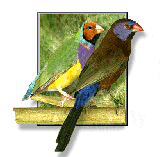Breed: Finches
Temperament: Timid
Cost: from $10-$100 or more for a pair
Lifespan: 5 years
Recommended for: Beginners to experienced bird keepers
Maintenance: Low-med
History
There is a large range of finches available in specialist bird shops around Australia including many native but also foreign birds in a range of colours. Native finches commonly kept in backyard aviaries include the Emblema Finch, also known as a Painted Finch (Emblema pictum), Zebra Finches, and Gouldian Finches. Other Australian finches include Star Finches and Blood Finches.
Many of the foreign finches – that is finches which are not native to Australia – have started to come available, including Pytilias and Cordon Bleus, (both African finches).
Housing and feeding
Finches are best kept in aviaries (for example the Burke’s Backyard Aviary which we built on the show). The aviary shown on the segment was an open aviary in a backyard. Although a large, open aviary could accommodate many finches, only a small number of breeding pairs can be housed together (see Breeding).
Finches are seed eaters and can be fed a good quality millet mix.
Tip: Place seed in a hanging seed dish. This will prevent mice from easily reaching the food. A covered feeder is recommended if the aviary doesn’t have a roof.
As well as seed allow finches access to a range of other foods including:
Seeding grasses which can be grown in the aviary. Try any grass growing naturally in your lawn or garden such as summer grass or guinea grass. These provide fresh seed but also attract insects. Green seed and insects are a vital part of the diet when finches are breeding.
Warning: Be cautious of seed grasses collected outside your property, for example from a park, as these may have been sprayed with chemicals that are harmful to birds.
Termites are a real treat for finches. If you know of a termite nest on the ground it is possible to bring some of it home to become food for your birds. Store the nest in a garbage bin. Place pieces of wood on top of the nest and termites will climb between them to feed. Gently lift the wood and tap the pieces together to dislodge and collect the termites. These can be fed live each day to your birds.
Meal worms, which really are not worms but the larvae of a beetle, are usually available from most good pet shops, particularly those which specialise in selling birds.
Breeding
The bad news about keeping any birds in aviaries is no matter how big the aviary each pair likes the aviary to itself. Sometimes you can mix two or three pairs in an aviary but that’s the limit because, like humans, they like to have their own home. Varieties such as the zebra need a minimum of around 2m x 2m (6×6′) per pair.
Nesting hints
Plastic mesh rolled into a cylinder, stuffed with tea tree or paperbark and hooked on a post can provide a nesting site. The size of the mesh needs to be about 4cm (1.5″). A very open steel mesh can also be used.
Starting out
Zebra finches are a good choice for the first-time bird keeper. They are often sold at local pet shops very cheaply, (under $10 a pair). The zebras will breed easily, and after mastering zebra finches it’s possible to move on to other species such as the Emblema, which is also very docile and easy to breed.
Note: People keeping native finches need to checkwith their State Department of Wildlife for necessary permits.
Health
A key aspect of setting up an aviary of finches is quarantine, that is taking care to keep diseases out of your aviary. To do this take the following precautions:
buy birds from a single, reliable dealer;
keep feeding dishes clean; and
provide fresh water and feed daily, and remove any soiled food or scraps.
Uses
As well as providing an interest, just watching birds living happily in an aviary is most relaxing. According to Don Burke, sitting down and watching finches after a stressful day is better than a three week holiday!
Choosing a supplier:
Hunt out specialist bird dealers in your area. Our segment was filmed at Kellyville Pets in Sydney, but there are good bird shops around Australia.
Kellyville Pets
106b Windsor Road
Kellyville NSW 2155
Phone: (02) 9629 3282
To find a reputable dealer in your area
Contact the Australian Birdkeeper magazine, (see details below).
Or contact the Finch Society of Australia
President: Douglas Hill
PO Box 9
St Marys NSW 1790
Phone: (02) 9623 2850.
Or contact the Avicultural Society of Australia
Secretary: Graeme Hyde
52 Harris Road
Elliminyt VIC 3249
Phone: (03) 5231 4510
Fax: (03) 5231 1390.
Some important tips to look for when choosing a bird shop:
Make sure the cages are well laid out.
Make sure the cages and the rest of the shop is clean.
Birds that are not kept in clean conditions can sicken and die.
Recommended reading
The Australian Birdkeeper magazine is published each month and is full of advice, tips and contacts for the amateur or expert bird enthusiast. It is available from selected newsagents or contact them direct:
The Australian Birdkeeper
PO Box 6288
Tweed Heads South NSW 2486
Phone: (07) 5590 7777 (local) 1800 633 493 (other)
Fax: (07) 5590 7130
e-mail: [email protected]
Did you know?
Australian Gouldian Finches nest in dark hollows in trees in the wild, or in nesting boxes in captivity. The young birds have four “glow-in-the-dark” beads, two either side of the beak to aid the parent in feeding the young in the nest. The adult looks for the four “glow-in-the-dark” beads near the beak and places the food in between those beads.



